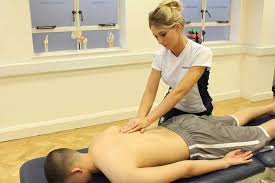Al Nahda Spa Dubai
Trigger Point Therapy
Presentation
Clinical back rub treatment system comprises of activation of skin, sash and solid tissue, trigger point treatment, and post-isometric unwinding procedures. Every one of these modalities is similarly significant to arrive at fast and supported outcomes. For quite a long time, enormous use of clinical back rub has demonstrated to be a protected and exceptionally powerful technique for treatment for the help and development framework issues, internal organ problems, stress the executives, and the sky is the limit from there. Al Nahda Spa Dubai
Over the most recent couple of years, there have been various contentions in inside the expert local area about professionals using manual treatment and trigger point treatment. In ongoing expert distributions numerous creators have been bringing up the accompanying issues: Is a trigger point a development of fibroconnective tissue in muscles? Have histological investigations at any point been done on trigger focuses? Is there a hypothesis of fringe nerve torment at the engine end plate another hypothesis and the lone hypothesis? Are ischemic pressure strategies for trigger point treatment protected and viable?
The short answers on previously mentioned questions are:
1. Fibroconnective tissue arrangement in muscles is myogelosis, a hopeless solid pathology.
2. As a rule myogelosis is the aftereffect of insufficient treatment of trigger focuses.
3. A trigger point is a pinpoint limitation of agony that can be found in muscles, connective tissue, and periosteum. The morphology of this place of torment is with the end goal that the interest of blood supply is a lot higher than the genuine blood supply.
4. The hypothesis of fringe nerve torment at the engine end plate is definitely not another hypothesis.
5. Any hypothesis should be upheld by clinical yield.
6. Ischemic pressure as a strategy for trigger point treatment has been demonstrated by in any event forty years of gigantic use as a protected and viable technique.
7. Ischemic pressure procedures are applied by step by step expanding pressure, in this way barring the chance of doing mischief to the patient and to the advisor.
In the quest for genuine comprehension of pathophysiology, the body's refinement and intricacy expects us to adopt an integrative strategy to any issue. Along these lines I might want to present to the peruser a short logical audit of the trigger point issue and the trigger point treatment idea.
The Nature of Trigger Points
There is no assertion in the cutting edge logical writing that considers a trigger point a "rigid band of fibro-connective tissue." However, it was once utilized in the late nineteenth/mid twentieth century until histological examinations directed by German researchers (Glogowski, and Wallraff, 1951; Miehlke et al., 1950) showed that there is no connective tissue multiplication (myogelosis) in the space of a trigger point in muscles. "As we would like to think, fibrositis (as to trigger focuses) has become a pitifully vague finding... is best kept away from" (Travell, Simons, 1983). Notwithstanding, connective tissue will develop between muscle strands when a center of the myogelosis is framed (Glogowski, and Wallraff, 1951). Myogelosis is a clinical result of long periods of reactivation of the dynamic trigger point in a similar region. Simultaneously, trigger point treatment is futile if the center of the myogelosis is as of now shaped.
In 1843, interestingly, the German doctor Dr. F. Froriep portrayed trigger focuses as agonizing arrangement in skeletal muscles. In 1921 another German researcher, Dr. H. Schade, analyzed them histologically and framed the idea of myogelosis. In 1923 the British doctor Dr. J. Mackenzie offered the first pathophysiological clarification of the trigger point development instrument and defined the idea of the reflex zones in the skeletal muscles where the focal and fringe sensory system assume a basic part. The reflex zones idea was additionally evolved by the American researcher Prof. I. Korr in 1941 in a progression of splendidly planned test contemplates. Consequently, the trigger point idea was grown well before crafted by Travell and Simons, who based their distribution (see references in "Trigger Point Manual" by Travell and Simons) on crafted by the researchers referenced.
There are various distributed consequences of histological assessments of the trigger point regions. Indeed, even in the short rundown of references toward the finish of this article you can discover sufficient proof under references 5, 6, 7, 13, and 15.
It is deluding to express that Dr. Travell and Dr. Simons suggested utilizing ischemic pressure for trigger point treatment. They upheld infusion, stretch and shower procedures, and muscle energy methods for trigger point treatment. Despite the fact that, Travell and Simons referenced ischemic pressure as a choice dependent on the European clinical sources, they never suggested it as a treatment strategy.
The Role of Vasodilators in Local Ischemia
Awad (1973) analyzed biopsy tissues from trigger focuses utilizing an electron magnifying lens and recognized a huge expansion in the quantity of platelets, which caused the arrival of serotonin and pole cells, which thusly delivered histamine. Both serotonin and histamine are strong vasodilators and their increment is an obvious indicator that body is attempting to battle the nearby ischemia in the trigger point region. In his now traditional work, Fassbender (1975) led a histological assessment of the flow in the space of the trigger point and demonstrated unequivocally that "... the trigger point addresses a district of nearby ischemia." similar outcomes were acquired by Popelansky et al., (1986) who utilized radioisotope assessment of blood course in the space of the trigger point. Massage Center in Al Nahda
The End Plate Theory
The end plate hypothesis is definitely not another hypothesis. Travell and Simmons continually underscore the sensory system as a basic factor in the improvement of the trigger point and point out the significance of end-plate zones. They even name uncommon kinds of trigger focuses called "engine trigger focuses," which are situated in the muscle paunch at the neuromuscular intersection.




Comments
Post a Comment